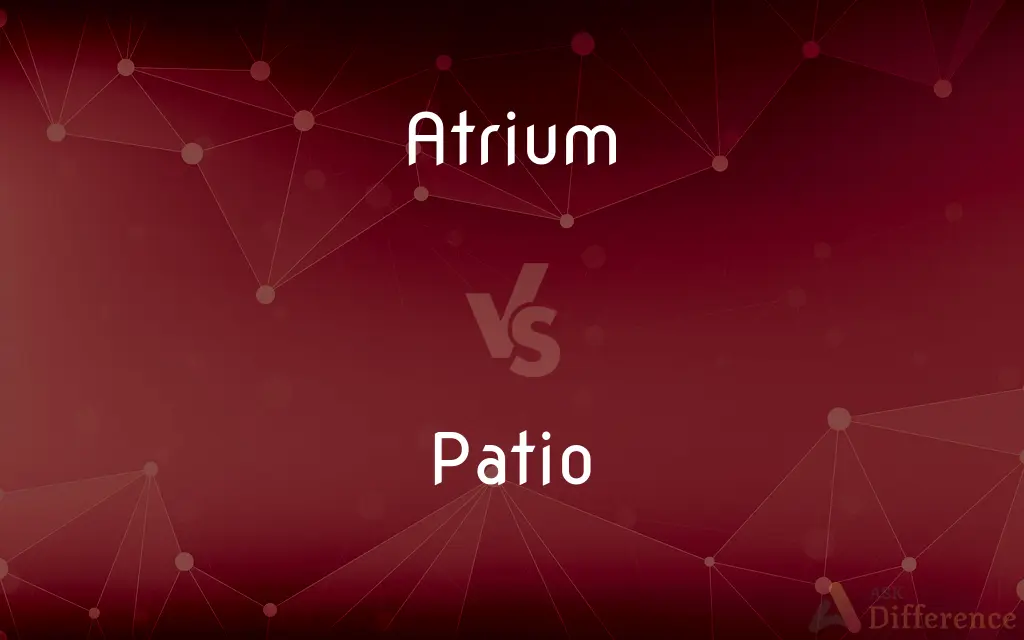Atrium vs. Patio — What's the Difference?
By Maham Liaqat & Urooj Arif — Updated on March 25, 2024
An atrium is a large open space within a building, often with a skylight, while a patio is an outdoor area adjoining a house, usually paved and used for dining or recreation.

Difference Between Atrium and Patio
Table of Contents
ADVERTISEMENT
Key Differences
An atrium, traditionally found in large public or commercial buildings, serves as a central space often used for light, ventilation, or as a social or communal area. In contrast, a patio is explicitly designed for outdoor leisure activities, typically adjoining a residence and used for dining, lounging, or entertaining.
While atriums can be characterized by their architectural features such as glass roofs or large open spaces that may span multiple floors, patios are defined by their outdoor setting, often featuring garden furniture, paving, and sometimes outdoor cooking facilities.
Atriums often function as the focal point of a building, providing a sense of openness and natural light indoors, and can feature plants, water elements, or art to enhance their appeal. Patios, however, are more intimately connected with the landscape and outdoor environment, blending the comforts of indoor living with the pleasures of the outdoors.
The design of an atrium can significantly influence the ambiance and functionality of the building, contributing to energy efficiency through natural lighting and ventilation. On the other hand, the design of a patio focuses on creating a comfortable and versatile outdoor living space, often incorporating elements like fire pits, outdoor kitchens, and landscaping to enhance the outdoor experience.
In terms of usage, atriums can serve various functions including lobbies, waiting areas, or event spaces within commercial, institutional, or residential buildings. Patios, however, are primarily used for personal relaxation and social gatherings, offering a private space for enjoyment and outdoor activities.
ADVERTISEMENT
Comparison Chart
Location
Inside a building, often central
Adjoining a house, outdoors
Design
Open space, possibly multi-storied, often with a skylight
Outdoor area, usually paved, designed for leisure
Function
Light, ventilation, communal space
Dining, lounging, entertaining outdoors
Key Features
Skylights, indoor plants, open galleries
Garden furniture, paving, outdoor cooking facilities
Connection
To the indoors, enhancing building ambiance
To the outdoor environment and landscape
Usage
Social, communal activities within buildings
Personal relaxation, social gatherings outside
Architectural Focus
Enhancing indoor spaces with openness and light
Blending indoor comfort with outdoor pleasures
Compare with Definitions
Atrium
A large open space within a building, often featuring a glass roof.
The hotel's atrium was breathtaking, with a towering glass ceiling and lush greenery.
Patio
Focuses on comfortable outdoor living spaces.
The patio was furnished with comfortable seating and a fire pit for chilly evenings.
Atrium
Contributes to the building's ambiance and energy efficiency.
The airy atrium added a sense of space and light to the otherwise compact building.
Patio
An outdoor area adjoining a residence, used for dining and recreation.
Their new home featured a spacious patio perfect for summer barbecues.
Atrium
Characterized by openness and natural lighting.
The office building featured an atrium that spanned several floors, filling the space with daylight.
Patio
Often incorporates landscaping, paving, and outdoor amenities.
The intricately paved patio was surrounded by fragrant flowers and soft landscape lighting.
Atrium
Serves as a communal or social space within buildings.
The atrium doubled as a lounge area, where employees could relax and collaborate.
Patio
Integrates the home with the surrounding landscape.
The patio offered a seamless transition from the living room to the lush garden.
Atrium
Often includes indoor plants, water features, or artwork.
The atrium's centerpiece was a stunning water fountain surrounded by tropical plants.
Patio
Designed for dining, lounging, and entertaining outdoors.
They hosted their annual family reunion on the large patio, equipped with an outdoor kitchen.
Atrium
An open-roofed entrance hall or central court in an ancient Roman house.
Patio
A patio (, from Spanish: patio [ˈpatjo]; "courtyard", "forecourt", "yard") is an outdoor space generally used for dining or recreation that adjoins a residence and is typically paved. In Australia the term is expanded to include roofed structures such as a veranda, which provides protection from sun and rain.
Atrium
A usually skylit central area, often containing plants, in some modern buildings, especially of a public or commercial nature.
Patio
An outdoor space for dining or recreation that adjoins a residence and is often paved.
Atrium
The open area in the center of an ancient Roman house.
Patio
A roofless inner courtyard, typically found in Spanish and Spanish-style dwellings.
Atrium
The forecourt of a building, such as an early Christian church, enclosed on three or four sides with porticoes.
Patio
A paved outside area, adjoining a house, used for dining or recreation.
Atrium
(architecture) A central room or space in ancient Roman homes, open to the sky in the middle; a similar space in other buildings.
Patio
An inner courtyard typical of traditional houses in some regions of Spain.
The flat looks out on a patio on one side and a churro café on on the other.
Atrium
(architecture) A square hall lit by daylight from above, into which rooms open at one or more levels.
Patio
A paved yard or floor where ores are cleaned and sorted, or where ore, salt, mercury, etc., are trampled by horses, to effect intermixture and amalgamation.
Atrium
(anatomy) A cavity, entrance, or passage.
An atrium of the infundibula of the lungs
Patio
In Spain, Spanish America, etc., a court or courtyard of a house or other building; esp., an inner court open to the sky.
Atrium
(biology) Any enclosed body cavity or chamber.
Patio
A usually paved area adjacent to a dwelling, used for outdoor lounging, dining, receptions of guests, etc.
Atrium
(anatomy) A microscopic air sac within a pulmonary alveolus.
Patio
Usually paved outdoor area adjoining a residence
Atrium
A square hall lighted from above, into which rooms open at one or more levels.
Atrium
The main part of either auricle of the heart as distinct from the auricular appendix. Also, the whole articular portion of the heart.
Atrium
A cavity in ascidians into which the intestine and generative ducts open, and which also receives the water from the gills. See Ascidioidea.
Atrium
A cavity, entrance, or passage; as, the atrium, or atrial cavity, in the body wall of the amphioxus; an atrium of the infundibula of the lungs, etc.
Atrium
Any chamber that is connected to other chambers or passageways (especially one of the two upper chambers of the heart)
Atrium
The central area in a building; open to the sky
Common Curiosities
How is a patio typically used?
A patio is typically used for outdoor dining, lounging, and entertaining, offering a comfortable space adjacent to a house for relaxation and social activities.
What materials are commonly used for patio surfaces?
Common materials for patio surfaces include concrete, pavers, stone, brick, and tiles, chosen for their durability and aesthetic appeal.
How does an atrium benefit a building's design?
An atrium benefits a building's design by providing natural light, enhancing spatial quality, and potentially improving energy efficiency through passive solar heating and natural ventilation.
Are atriums energy efficient?
Atriums can be energy efficient by facilitating natural light and ventilation, reducing the need for artificial lighting and cooling, depending on their design.
What features can enhance a patio's functionality?
Features such as outdoor kitchens, fire pits, comfortable seating, shading elements, and landscaping can enhance a patio's functionality and aesthetic appeal.
What defines an atrium in architecture?
An atrium is defined by its large open space within a building, often with a glass roof or skylight, designed to provide natural light and serve as a communal area.
How do atriums affect a building's ambiance?
Atriums can significantly affect a building's ambiance by creating a sense of openness, bringing in natural light, and often serving as a visually appealing focal point.
Is an atrium considered an indoor or outdoor space?
An atrium is considered an indoor space, although its design may incorporate outdoor elements like plants and natural light to mimic an outdoor feel.
Can atriums be found in residential buildings?
Yes, atriums can be found in residential buildings, especially in larger homes or apartment complexes, where they serve as light-filled communal spaces.
Can a patio be covered?
Yes, patios can be covered with pergolas, awnings, or roof structures to provide shade and protection from the elements, extending their usability.
What are the benefits of having a patio?
The benefits of having a patio include increased outdoor living space, enhanced enjoyment of the outdoor environment, and a potential increase in property value.
Can atriums have multiple levels?
Yes, atriums can span multiple levels or floors of a building, with balconies or galleries overlooking the central open space.
How do seasonal changes affect the use of patios?
Seasonal changes can greatly affect the use of patios, with features like heaters and covers extending their use into cooler months, while hot weather may require shading or cooling features.
Share Your Discovery

Previous Comparison
Dusk vs. Evening
Next Comparison
Coarse vs. RoughAuthor Spotlight
Written by
Maham LiaqatCo-written by
Urooj ArifUrooj is a skilled content writer at Ask Difference, known for her exceptional ability to simplify complex topics into engaging and informative content. With a passion for research and a flair for clear, concise writing, she consistently delivers articles that resonate with our diverse audience.
















































